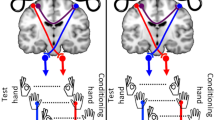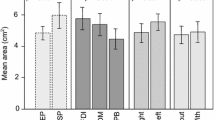Abstract
The objective of this study was to investigate interhemispheric transcallosal connections between primary motor cortices noninvasively in awake human subjects. For this purpose, focal transcranial magnetic stimulation was performed on eight healthy, right-handed subjects and one patient with congenital collosal agenesis. Using two magnetic stimulators, we investigated the effect of a conditioning magnetic stimulus applied to the motor cortex of one hemisphere on the duration of the silent period (SP) evoked in the first dorsal interosseus (FDI) muscle by a magnetic test stimulus given over the opposite motor cortex. It is well established that SP reflects activation of inhibitory interneurons within primary motor cortex. In all normal subjects, a conditioning stimulus to one hemisphere produced a significant shortening of SP evoked by the test stimulus when the conditioningtest-interval was 10–20 ms. The effect was also observed when an electrical test stimulus was used. The conditioning coil had to be placed over the hand motor area to obtain the maximal effect. The threshold for eliciting this decrease of SP duration was higher than the threshold for eliciting an early excitatory muscle response in the contralateral FDI. Increasing the intensity of the conditioning stimulus led to linear reduction of SP duration. In the patient with callosal agenesis, no such decreasing effect on SP duration was observed. These results suggest that inhibitory interneurons within primary hand motor cortex receive transcallosal inhibitory input from the opposite motor cortex. We propose that modulation of motor cortical interneurons via transcallosal pathways may provide a gain control for the motor cortical output system and subserve interhemispheric coordination in complex, nonsymmetrical bimanual movements.
Similar content being viewed by others
References
Aboitiz F, Scheibel AB, Fisher RS, Zeidel E (1992) Fiber composition of the human corpus callosum. Brain Res 598:143–153
Amassian VE, Cracco RQ (1987) Human cerebral cortical responses to contralateral transcranial stimulation. Neurosurgery 20(1):148–155
Asanuma H, Okuda O (1962) Effects of transcallosal volleys on pyramidal tract cells. J Neurophysiol 25:198–208
Atlas SW, Zimmermann RA, Bilanski LT, Rorke L, Hackney DB, Goldberg HI, Grossman RI (1986) Corpus callosum and limbic system: neuroanatomic MR evaluation of developmental anomalies. Radiology 160:335–362
Braun CM (1992) Estimation of interhemispheric dynamics from simple unimanual reaction time to extrafoveal stimuli. Naeuropsychol Rev 3:321–365
Brown P, Day BL, Rothwell JC, Thompson PD, Marsden CD (1991) Intrahemispheric and interhemispheric spread of cerebral cortical myoclonic activity and its relevance to epilepsy. Brain 114:2333–2351
Catsman-Berrevoets CE, Lemon RN, Vanbirgh CA, Bentivoglio M, Kuypers HGJM (1980) Absence of callosal collaterals derived from rat cortico-spinal neurones. A study using fluorescent retrograde tracing and electrophysiological techniques. Exp Brain Res 39:433–440
Chiarello C (1980) A house divided? Cognitive functioning with callosal agenesis. Brain Lang 11:128–158
Cracco RQ, Amassian VE, Maccabee PJ, Cracco JB (1989) Comparison of human transcallosal responses evoked by magnetic coil and electrical stimulation. Electroencephalogr Clin Neurophysiol 74:417–424
Day BL, Dressler D, Maertens de Noordhout A, Marsden CD, Nakashima K, Rothwell JC, Thompson PD (1989) Electric and magnetic stimulation of human motor cortex: surface EMG and single motor unit responses. J Physiol (Lond) 412:449–473
Day BL, Rothwell JC, Thompson PD, Dick JP, Cowan JM, Berardelli A (1987) Motor cortex stimulation in intact man. 2. Multiple descending volleys. Brain 209:1191–1209
Di Stefano M, Morelli M, Marzi CA, Berlucchi G (1980) Hemispheric control of unilateral and bilateral movements of proximal and distal parts of the arm as inferred from simple reaction time to lateralized light stimuli in man. Exp Brain Res 38:197–204
Edgley S, Eyre JA, Lemon RN, Miller S (1990) Excitation of the corticospinal tract by electromagnetic and electrical stimulation of the scalp in the macaque monkey. J Physiol (Lond) 425: 301–320
Ferbert A, Priori A, Rothwell JC, Colebatch J, Marsden CD (1992) Transcallosal inhibition of the human motor cortex. J Physiol (Lond) 453:525–546
Fuhr P, Agostino R, Hallett M (1991) Spinal motor neuron excitability during the silent period after cortical stimulation. Electroencephalogr Clin Neurophysiol 81:257–262
Giesen HJ von, Roick H, Benecke R (1994) Inhibitory actions of motor cortex followeing unilateral brain lesions as studied by magnetic brain stimulation. Exp Brain Res 99:84–96
Gould HJ, Cusick CG, Pons TP, Kaas JH (1986) The relationship of corpus callosum connections to electrical stimulation maps of motor, supplementary motor, and the frontal eye fields in owl monkeys. J Comp Neurol 247:297–325
Inghilleri M, Berardelli A, Cruccu G, Manfredi M (1993) Silent period evoked by transcranial magnetic stimulation of the human cortex and cervicomedullary junction. J Physiol (Paris) 34: 521–534
Innocenti GM (1986) General organisation of callosal connections in the cerebral cortex. In: Jones EG, Peters A (eds) Cerebral cortex. Plenum, New York, pp 291–353
Jäncke L, Steinmetz H (1994) Interhemispheric transfer time and corpus callosum size. Neuroreport 5:2385–2388
Jeannerod M (1986) The role of vision in the patterning of prehension movements. In: Lepore F, Ptito M, Jasper HH (eds) Two hemispheres — one brain: functions of the corpus callosum. Liss, New York, pp 423–435
Jeeves MA, Silver PH, Milne AB (1988) Role of the corpus callosum in the development of a bimanual skill. Dev Neuropsychol 4:305–323
Jinkins JR, Whitmore AR, Bradley WG (1989) MR imaging of callosal and corticocallosal dysgenesis. Am J Neuroradiol 10: 329–344
Kujirai T, Caramia MD, Rothwell JC, Day BL, Thompson PD, Ferbert A, Wroe S, Asselman P, Marsden CD (1993) Corticocortical inhibition in human motor cortex. J Physiol (Lond) 471: 501–519
Laget P, Raimbault J, D'Allest AM, Flores-Guevara R, Mariani J, Thierot-Prevost G (1976) La maturation des potentiels evoques somesthiques (PES) ches l'homme. Electroencephalogr Clin Neurophysiol 40:499–515
Laget P, D'Allest AM, Fihey R, Lortholary O (1977) L'interet des potentiels evoques somesthiques homolateraux dans les agenesis du corps calleux. Rev Electroencephalogr Neurophysiol Clin 7:498–502
Marzi CA, Bisiacchi P, Nicoletti R (1991) Is interhemispheric transfer of visuomotor information asymmetric? Evidence from a meta-analysis. Neuropsychologia 29:1163–1177
Matsunami K, Hamada I (1984) Effects of stimulation of corpus callosum on precentral neuron activity in the awake monkey. J Neurophysiol 52:676–691
Meyer BU, Röricht S, Einsiedel H von, Kruggel F, Weindl A (1995) Inhibitory and excitatory interhemispheric transfer between motor cortical areas in normal humans and patients with abnormalities of the corpus callosum. Brain 118:429–440
Patton HE, Amassian VE (1954) Single and multiple unit analysis of cortical stage of pyramidal tract activation. J Neurophysiol 17:345–363
Ridding MC, Inzelberg R, Rothwell JC (1995) Changes in excitability of motor cortical circuitry in patients with Parkinson's disease. Ann Neurol 37:181–188
Roick H, Giesen HJ von, Benecke R (1993) On the origin of the postexcitatory inhibition seen after transcranial magnetic brain stimulation in awake human subjects. Exp Brain Res 94:489–498
Sauerwein HC, Lassonde M (1994) Cognitive and sensori-motor functioning in the absence of the corpus callosum: neuropsychological studies in callosal agenesis and callosotomized patients. Behav Brain Res 64:229–240
Schieppatti M, Musazzi M, Nardone A, Seveso G (1984) Interhemispheric transfer of voluntary commands in man. Electroencephalogr Clin Neurophysiol 57:441–447
Schnitzler A, Benecke R (1994) The silent period after transcranial magnetic stimulation is of exclusive cortical origin: evidence from isolated cortical ischemic lesions in man. Neurosci Lett 180:41–45
Schnitzler A, Kessler KR, Benecke R (1994) Transcallosal disinhibition of primary motor cortex induced by transcranial magnetic stimulation. Soc Neurosci Abstr 20:443
Seymour SE, Reuter-Lorenz PA, Gazzaniga MS (1994) The disconnection syndrome. Basic findings reaffirmed. Brain 117:1065–1115
Shibasaki H, Yamashita Y, Kuroiwa J (1978) Electroencephalographic studies of myoclonus. Brain 101:447–460
Silver PH, Jeeves MA (1994) Motor coordination in callosal agenesis. In: Lassonde M, Jeeves MA (eds) Callosal agenesis. Plenum, New York, pp 207–219
Ugawa Y, Hanajima R, Kanazawa I (1993) Interhemispheric facilitation of the hand area of the human motor cortex. Neurosci Lett 160:153–155
Uozumi T, Tsuji S, Murai Y (1991) Motor potentials evoked by magnetic stimulation of the motor cortex in normal subjects and patients with motor disorders. Electroencephalogr Clin Neurophysiol 81:251–256
Werhahn K, Fong JKY, Meyer BU, Priori A, Rothwell JC, Day BL, Thompson PD (1994) The effect of coil orientation on the latency of surface EMG and single motor unit responses in the first dorsal interosseus muscle. Electroencephalogr Clin Neurophysiol 93:138–146
Wilkins DE, Hallett M, Berardelli A, Walshe T, Alvarez N (1984) Physiologic analysis of the myoclonus of Alzheimer's disease. Neurology 34:898–903
Wilson SA, Thickbroom GW, Mastaglia FL (1993) Transcranial magnetic stimulation mapping of the motor cortex in normal subjects. The representation of two intrinsic hand muscles. J Neurol Sci 118:134–144
Author information
Authors and Affiliations
Rights and permissions
About this article
Cite this article
Schnitzler, A., Kessler, K.R. & Benecke, R. Transcallosally mediated inhibition of interneurons within human primary motor cortex. Exp Brain Res 112, 381–391 (1996). https://doi.org/10.1007/BF00227944
Received:
Accepted:
Issue Date:
DOI: https://doi.org/10.1007/BF00227944




